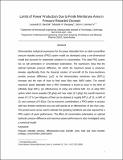| dc.contributor.author | Banchik, Leonardo David | |
| dc.contributor.author | Sharqawy, Mostafa H. | |
| dc.contributor.author | Lienhard, John H. | |
| dc.date.accessioned | 2016-06-21T14:38:34Z | |
| dc.date.available | 2016-06-21T14:38:34Z | |
| dc.date.issued | 2014-10 | |
| dc.date.submitted | 2014-05 | |
| dc.identifier.issn | 03767388 | |
| dc.identifier.issn | 1873-3123 | |
| dc.identifier.uri | http://hdl.handle.net/1721.1/103172 | |
| dc.description.abstract | Dimensionless analytical expressions for the power attainable from an ideal counterflow pressure retarded osmosis (PRO) system model are developed using a one-dimensional model that accounts for streamwise variations in concentration. This ideal PRO system has no salt permeation or concentration polarization. The expressions show that the optimal hydraulic pressure difference, for which the maximum power is produced, deviates significantly from the classical solution of one-half of the trans-membrane osmotic pressure difference, Δπ/2, as the dimensionless membrane area (MTUπ) increases and the ratio of draw to feed mass flow rates (MR) varies. The overall maximum power attainable from a PRO membrane is found to occur in the limit of infinitely large MTUπ (an effectiveness of unity) and infinite MR. For an ideal PRO system which mixes seawater (35 g/kg) and river water (1.5 g/kg), the overall maximum power of 1.57 kJ/kg of feed can be attained at roughly MTUπ of 15, an MR of 10, and a pressure of 0.83Δπ. Due to economic considerations, a PRO system in practice will have limited membrane area and will operate at an effectiveness of less than unity. The present work can be used to estimate the operating conditions and area required for a PRO system of given performance. The effect of concentration polarization on optimal hydraulic pressure difference and maximum power performance is also investigated using a numerical model | en_US |
| dc.description.sponsorship | National Science Foundation (U.S.) (Graduate Research Fellowship Program, Grant no. 1122374) | en_US |
| dc.description.sponsorship | King Fahd University of Petroleum and Minerals | en_US |
| dc.language.iso | en_US | |
| dc.publisher | Elsevier | en_US |
| dc.relation.isversionof | http://dx.doi.org/10.1016/j.memsci.2014.05.021 | en_US |
| dc.rights | Creative Commons Attribution-Noncommercial-Share Alike | en_US |
| dc.rights.uri | http://creativecommons.org/licenses/by-nc-sa/4.0/ | en_US |
| dc.source | Banchik | en_US |
| dc.title | Limits of power production due to finite membrane area in pressure retarded osmosis | en_US |
| dc.type | Article | en_US |
| dc.identifier.citation | Banchik, Leonardo H., Mostafa H. Sharqawy, and John H. Lienhard V. "Limits of power production due to finite membrane area in pressure retarded osmosis." Journal of Membrane Science 468 (15 October 2014), pp. 81–89. | en_US |
| dc.contributor.department | Massachusetts Institute of Technology. Department of Mechanical Engineering | en_US |
| dc.contributor.approver | Lienhard, John H. | en_US |
| dc.contributor.mitauthor | Banchik, Leonardo David | en_US |
| dc.contributor.mitauthor | Lienhard, John H. | en_US |
| dc.relation.journal | Journal of Membrane Science | en_US |
| dc.eprint.version | Author's final manuscript | en_US |
| dc.type.uri | http://purl.org/eprint/type/JournalArticle | en_US |
| eprint.status | http://purl.org/eprint/status/PeerReviewed | en_US |
| dspace.orderedauthors | Banchik, Leonardo D.; Sharqawy, Mostafa H.; Lienhard, John H. | en_US |
| dspace.embargo.terms | N | en_US |
| dc.identifier.orcid | https://orcid.org/0000-0002-2901-0638 | |
| dc.identifier.orcid | https://orcid.org/0000-0003-0402-8185 | |
| mit.license | OPEN_ACCESS_POLICY | en_US |
